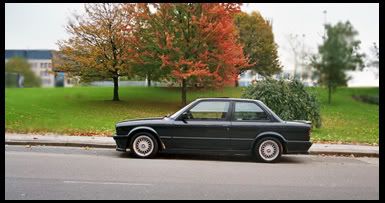I'll answer this from the speaker maker side. Be prepared for a book. hah.
The resonance of a speaker around 6.5" generally hovers around 70 hertz (give or take 20hz). Now, when you hit the resonance of a speaker, it moves the farthest distance at this point. This is where the parts of the speaker are stretched.
There is a limiting factor on all [decently designed] speakers to keep them from destroying their self. The limiting factor is usually one of two things. The first is the suspension system (the damper is the main factor in this which is the circular part underneath the cone and above the magnet) and the second is the magnetic strength.
What generally happens is the suspension is considered linear when it only moves a small distance (say 0.5 mm each direction). As the distance is increased, the suspension resistance increases (a bell curve). Think of a progressive increasing spring rate. As the speaker moves a greater distance, the suspension gets tighter and restricts this distance.
The other method is magnetic strength (bl as it is known in my world). The magnetic strength is only contained in a small area (relatively), and just like the suspension, the magnetic strength falls off in the bell curve method as you move the speaker more away from the center position.
These can be counteracted to a point by a few ways (if one chooses to remove the limits that protect the speaker which will cause your voice coil to smack and cause nasty sound and destruction) including partly rubber dampers (just like the cone, it has a rubber roll edge) and "longer" magnetic fields.
Also, when you hit this resonance frequency, harmonic distortions go through the roof, relatively speaking. At 1w, you'll usually hit 1%-5% (of the SPL) total distortion at the resonance and nearby the resonance, while the other frequencies may see a max of 0.5%. This distortion is what you hear as the crap coming from your sound system.
So basically, when you remove this resonance frequency (or at least cut the amount of production at this point down), you're removing A LOT of the limitations of your speaker.
Tweeters are entirely different.. They have no protection due to the fact they have no suspension nor magnetic strength limiting. They are missing these features because if it had them, the reproduction of 20kHz would be very difficult and inaccurate.
Some further explanation:
This resonance frequency causes the highest movement in the speaker which also yields the highest SLP of the speaker. Subwoofers have resonance frequencies very low. This low resonance is what allows you to get so much for your buck and the distortions are no longer a problem since the human ear has a hard time telling the difference between distortion and correct reproduction as the frequency drops, until you can no longer hear actual reproduction but just the distortion.
If I had a curve to display all of this, it would be a lot easier to understand, but alas, I'm not at work.
The resonance of a speaker around 6.5" generally hovers around 70 hertz (give or take 20hz). Now, when you hit the resonance of a speaker, it moves the farthest distance at this point. This is where the parts of the speaker are stretched.
There is a limiting factor on all [decently designed] speakers to keep them from destroying their self. The limiting factor is usually one of two things. The first is the suspension system (the damper is the main factor in this which is the circular part underneath the cone and above the magnet) and the second is the magnetic strength.
What generally happens is the suspension is considered linear when it only moves a small distance (say 0.5 mm each direction). As the distance is increased, the suspension resistance increases (a bell curve). Think of a progressive increasing spring rate. As the speaker moves a greater distance, the suspension gets tighter and restricts this distance.
The other method is magnetic strength (bl as it is known in my world). The magnetic strength is only contained in a small area (relatively), and just like the suspension, the magnetic strength falls off in the bell curve method as you move the speaker more away from the center position.
These can be counteracted to a point by a few ways (if one chooses to remove the limits that protect the speaker which will cause your voice coil to smack and cause nasty sound and destruction) including partly rubber dampers (just like the cone, it has a rubber roll edge) and "longer" magnetic fields.
Also, when you hit this resonance frequency, harmonic distortions go through the roof, relatively speaking. At 1w, you'll usually hit 1%-5% (of the SPL) total distortion at the resonance and nearby the resonance, while the other frequencies may see a max of 0.5%. This distortion is what you hear as the crap coming from your sound system.
So basically, when you remove this resonance frequency (or at least cut the amount of production at this point down), you're removing A LOT of the limitations of your speaker.
Tweeters are entirely different.. They have no protection due to the fact they have no suspension nor magnetic strength limiting. They are missing these features because if it had them, the reproduction of 20kHz would be very difficult and inaccurate.
Some further explanation:
This resonance frequency causes the highest movement in the speaker which also yields the highest SLP of the speaker. Subwoofers have resonance frequencies very low. This low resonance is what allows you to get so much for your buck and the distortions are no longer a problem since the human ear has a hard time telling the difference between distortion and correct reproduction as the frequency drops, until you can no longer hear actual reproduction but just the distortion.
If I had a curve to display all of this, it would be a lot easier to understand, but alas, I'm not at work.



Comment